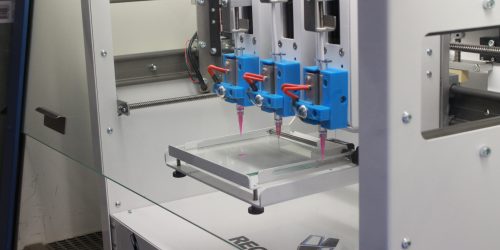
In Australia, someone experiences a heart attack every 10 minutes and as a consequence, a quarter of these patients will develop heart failure. For patients who develop end-stage heart failure, there is no real treatment.
Dr Carmine Gentile’s research involves working closely with cardiologists and cardiac surgeons to identify the best way to provide 3D bio-printed heart tissue for a patient who has suffered a heart attack. “We’re developing an approach that utilises biological material – in this case, cells taken from the same patient – to generate living heart tissue and to regenerate the infarcted heart,” Carmine explains.
Cells from the patient’s skin are used to produce stem cells. These are then cultured to produce heart cells by Dr Gentile and his team. The patient’s own heart cells can then be used as ‘bio-ink’ in the 3D bioprinter.
Dr Gentile and his team refer to this type of bio-ink as ‘mini-hearts’ (as they beat similar to real human heart tissue). The ‘bio-ink’ is loaded into the nozzle of the 3D bio-printer, which deposits (‘prints’) the cells layer-by-layer within a bio-compatible paper (or ‘hydrogel’).
These printed cells form a ‘patch’ which could then be used to replace the damaged tissue. The unique combination of skills in Dr Gentile’s team, which includes cardiac surgeons and cardiologists, is currently investigating the best approach to transplant the bio-printed patch to improve the heart function in heart attack patients.
Another component of Carmine’s research is exploring the use of these ‘mini-hearts’ to study the side effects medications can have on the heart. Last year he demonstrated that these ‘mini-hearts’ can be used to predict the toxic effect chemotherapy has on the heart within 24 hours of treatment.
Chemotherapy is used as a treatment for children who have leukaemia, and its use can lead to children developing heart failure years later. It is Carmine’s hope that these ‘mini-hearts’ could predict the toxic effects on the heart and provide a way to identify whether or not chemotherapy would have side effects on the young patient’s heart in the near future.
Carmine hopes his research could lead to the creation of 3D-printed human heart tissues, which would be life-saving for those in need of a transplant.
“Research is very costly, and securing funding is becoming increasingly competitive. Receiving funding from organisations, such as Heart Research Australia, is therefore critical for our research, and my team and I are extremely grateful for any support we receive from Heart Research Australia’s supporters.” – Dr Carmine Gentile
